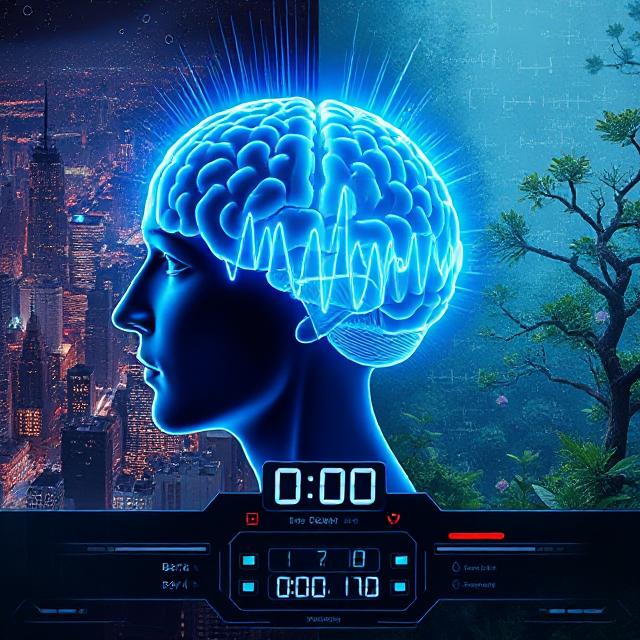
Table of Contents
Epsilon Waves: Unlocking Ultra-Slow Brain Power
While most conversations about brainwaves focus on alpha for relaxation or gamma for cognition, epsilon waves operate on a level that borders the mystical. These ultra-low frequency brainwaves are measured at below 0.5 Hz and have been associated with deep states of consciousness, advanced meditative awareness, and even out-of-body experiences. But how do they relate to memory, focus, and real-world learning?
This article explores the science, speculation, and real-world relevance of epsilon brainwaves—often overshadowed by their more mainstream cousins, but potentially one of the most fascinating frontiers in cognitive exploration.
What Are Epsilon Waves?
Epsilon waves are sub-delta frequency oscillations, typically recorded between 0.1 and 0.5 Hz. Because they occur so slowly, their detection requires advanced EEG technology and often shows up during altered states of consciousness rather than typical wakefulness or sleep.
Quick Brainwave Spectrum Reference
| Wave | Frequency | State of Consciousness |
|---|---|---|
| Gamma | 30–100 Hz | Focus, insight, peak cognition |
| Beta | 13–30 Hz | Alertness, problem-solving |
| Alpha | 8–13 Hz | Calm focus, light meditation |
| Theta | 4–8 Hz | Dreaming, intuition |
| Delta | 0.5–4 Hz | Deep sleep, regeneration |
| Epsilon | <0.5 Hz | Mystical states, deep trance |
Epsilon is not officially recognized in standard EEG classifications. It is an emerging concept primarily found in consciousness research, deep trance studies, and anecdotal reports from advanced meditation practitioners.
Epsilon and the Brain: What We Know So Far
Despite limited research, several fascinating observations suggest epsilon waves might play a hidden role in the brain’s cognitive architecture.
1. Link to Deep Trance and Consciousness
Practitioners of advanced yogic and meditative traditions, such as Tibetan monks or Samadhi meditators, have shown epsilon-like patterns during EEG monitoring. These individuals report:
- Timelessness or suspension of ego
- Profound clarity or spiritual vision
- Out-of-body or expanded awareness states
Such observations suggest epsilon may be tied to non-ordinary cognition, potentially supporting states of hyper-integration where the mind becomes deeply unified.
Some researchers propose that epsilon may function as a carrier wave for complex, low-noise cognitive processing—akin to a “zero-state” in the brain.
2. Nested with Gamma? A Frequency Paradox
A curious phenomenon is the co-occurrence of epsilon and gamma waves in some EEG studies. This paradoxical coupling—extremely slow with extremely fast—hints at a nested oscillatory system, where gamma bursts may ride on ultra-slow epsilon rhythms.
This relationship suggests that:
- Epsilon may act as a global coordinator, while
- Gamma handles localized integration and insight generation
This duality might be a physiological basis for deep, unified insight—where the slow rhythm sets the frame and the fast rhythm fills it with meaning.
3. Potential Role in Memory Consolidation
Because epsilon overlaps with deep regenerative sleep and altered states associated with long-term memory encoding, it may play a role in:
- Synaptic downscaling
- Neurochemical resets
- Integration of emotional and abstract memories
This is speculative but aligns with theories of global brain reset modes—ultra-slow waves enabling the brain to consolidate at the structural level.
When and How Epsilon Waves Emerge
Unlike alpha or beta states you can trigger with a playlist or breathing exercise, epsilon emerges slowly and subtly, often in fringe or extreme contexts.
States that May Trigger Epsilon
- Deep meditation or Samadhi
- Near-death experiences (NDEs)
- Hypnosis or trance channeling
- Floating in sensory deprivation tanks
- Lucid dreaming at the sleep-wake edge
- Post-orgasmic stillness in tantric practices
Epsilon states are non-verbal, immersive, and whole-body felt. You don’t think in epsilon—you are in it.
How Epsilon Waves Relate to Learning
Although epsilon waves are not typically linked to active study, they may serve as a substrate for metacognition, neurointegration, and long-term synthesis. Here’s how:
1. Afterglow Consolidation
After a study session, entering deep relaxation or meditative stillness may:
- Allow neural connections to strengthen
- Reduce information overload
- Create space for novel associations
Epsilon may be the silent space where insight gels.
2. Deep Restorative Recovery
Heavy mental workloads (like exam cramming or intensive coding) create neurochemical imbalances. Epsilon-linked states—like float tanks or extended shavasana—may offer:
- Cognitive reset
- Parasympathetic dominance
- Neural cleaning via glymphatic flow
You don’t always need more input. Sometimes you need deep stillness to allow synthesis.
3. Creativity Through Absence
Many artists and scientists report breakthroughs not in the act of thinking, but in the void that follows it. Epsilon states provide the neurological vacuum where subconscious processing emerges.
Think of it as “brainwave composting”—letting ideas decompose in the soil of stillness until something new sprouts.
How to Tap Into Epsilon States (If You Dare)
Because of their rarity, epsilon states cannot be “hacked” in the traditional sense. But certain conditions increase the likelihood of their appearance:
Tools & Practices
| Method | Effect |
|---|---|
| Yoga Nidra | Induces non-sleep deep rest (NSDR) |
| Sensory Deprivation (Float) | Shuts off exteroception, promoting internal flow |
| Tantric or Breath Retention | Manipulates inner states, opens theta–epsilon range |
| Deep Trance Hypnosis | Can generate ultra-low activity brain states |
| Meditation Retreats (10+ days) | May shift baseline rhythms and dissolve ego structures |
These practices cultivate non-linear awareness, not analytical learning. Epsilon isn’t for remembering facts—it’s for remembering your nature.
Note: Extended exposure to these practices can provoke ego dissolution, emotional release, or altered sense of self. Proceed with caution and guidance.
Epsilon in Science, Spirituality, and Speculation
While epsilon remains under-researched, it touches multiple realms of inquiry:
1. In Neuroscience
Epsilon is often grouped with “infra-slow activity” (<0.1 Hz), linked to:
- Default Mode Network (DMN) activity
- Homeostatic brain functions
- Ultra-deep sleep
Future technologies may better map how epsilon coordinates with brain-wide resets and long-range communication.
2. In Mystical Traditions
Many cultures point to ultra-slow “mindless” states as the highest form of consciousness:
- Buddhist Samadhi
- Christian contemplative prayer
- Sufi fana (annihilation of self)
- Advaita non-duality
These states describe timelessness, boundlessness, and unity—qualities mirrored in epsilon EEG signatures.
3. In Speculative Tech
Neurotech researchers and futurists have proposed using epsilon wave tracking for:
- Sleep optimization
- Lucid dreaming induction
- Consciousness enhancement
- Digital brainwave communication
Whether or not these ideas materialize, epsilon serves as a reminder that cognition is more than content—it’s consciousness itself.
Final Thoughts: Epsilon as Cognitive Ground Zero
Epsilon waves are not for cramming, reviewing, or active recall. They are the fertile ground beneath cognition—a base layer of ultra-slow synchrony that may support everything from healing to insight.
While their mysteries remain largely unmapped, one thing is clear: stillness is not emptiness. It is the hidden partner of intelligence.
When we stop thinking, something deeper begins to listen.
In the silence, epsilon speaks.




